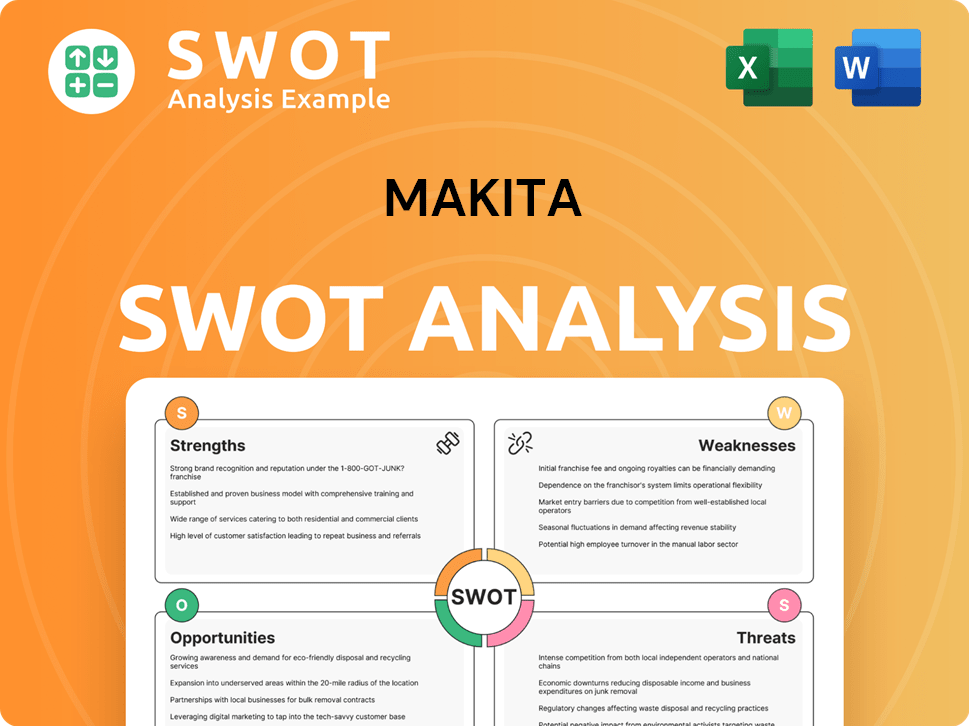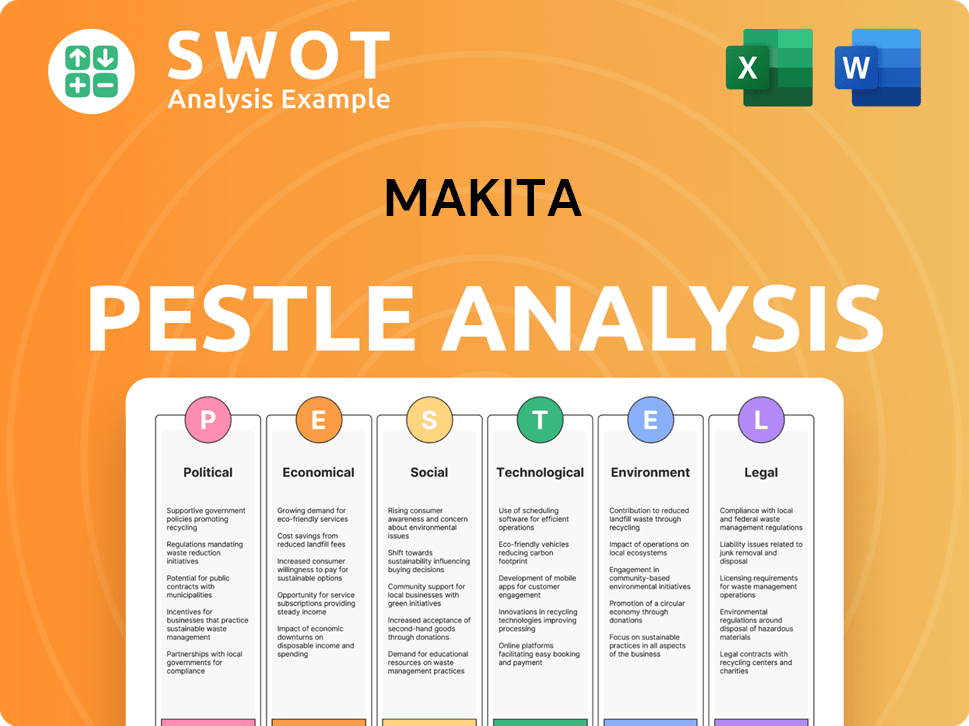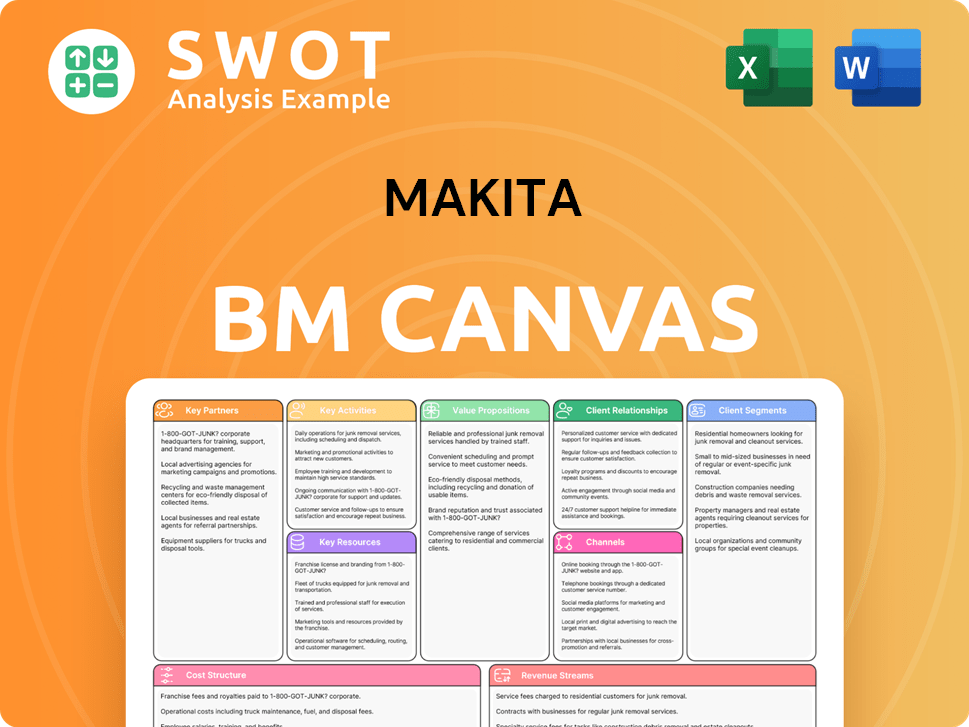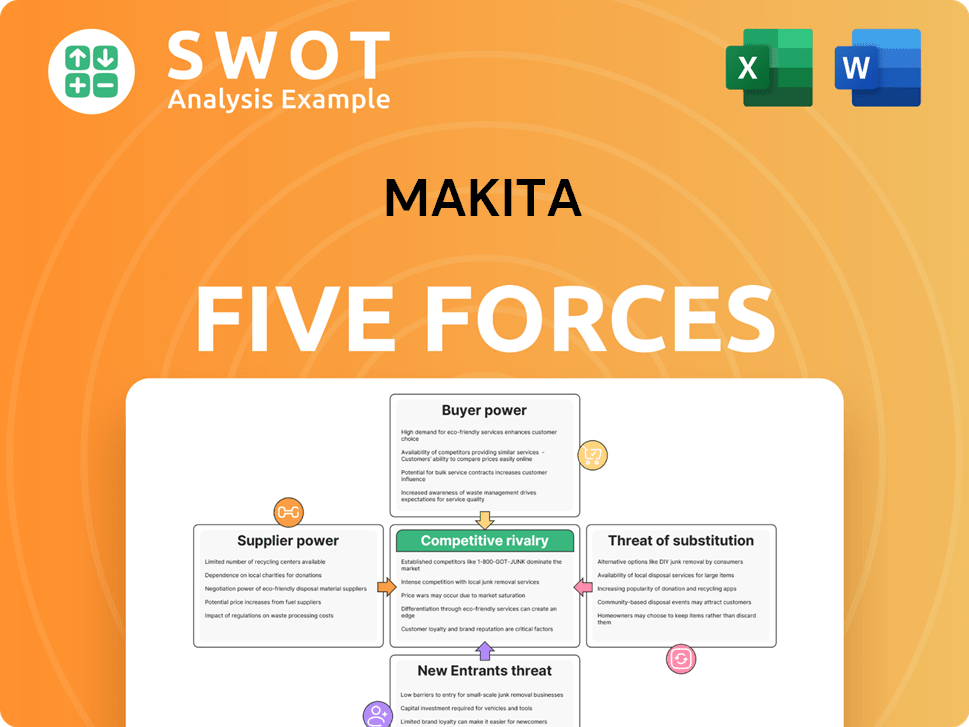Makita Bundle
How Did a Small Repair Shop Become a Power Tool Titan?
Ever wondered about the Makita SWOT Analysis and the journey of a company that dominates the power tool industry? From its origins in Japan to its global presence, Makita's story is one of relentless innovation and strategic growth. Discover how this Japanese tool manufacturer transformed from a humble electric motor repair shop into a world leader.

This article explores the rich Makita history, tracing the Makita company's evolution from its early years to its current status. Learn about the key milestones, including the introduction of cordless drills and the expansion of its product range. We'll examine how Makita tools have shaped the industry and its impact on professionals and DIY enthusiasts worldwide.
What is the Makita Founding Story?
The Makita company, a prominent name in the power tools industry, has a rich history that began in Japan. The story of Makita's founding is a testament to entrepreneurial vision and adaptability. This brief history of Makita tools reveals how a small business transformed into a global leader.
The Makita Corporation's origin dates back to March 21, 1915. Mosaburo Makita established Makita Electric Works in Nagoya, Aichi, Japan. The company's initial focus wasn't on power tools, but on the manufacturing and repair of electric motors, transformers, and lighting equipment. This early focus provided a strong foundation for future growth.
The early years of Makita were marked by a response to the industrializing environment of Japan. The company's success was built on repairing and selling essential electrical components. The founder's background in electrical engineering was crucial to the company's early operations. The company's name, reflecting its founder, was a common practice in Japan, highlighting personal commitment and quality.
The company started in 1915 with a focus on electrical equipment. It was founded by Mosaburo Makita in Nagoya, Japan.
- The initial business model centered on repairing and selling electric motors and transformers.
- The company's location was Nagoya, Japan, a city experiencing industrial growth.
- The founder's expertise was in electrical engineering.
- The company's early operations laid the groundwork for its future in power tools.
Makita SWOT Analysis
- Complete SWOT Breakdown
- Fully Customizable
- Editable in Excel & Word
- Professional Formatting
- Investor-Ready Format

What Drove the Early Growth of Makita?
The early growth of the Makita company saw a significant transformation from a repair shop to a manufacturing powerhouse. This expansion focused on producing electric motors and generators, which were crucial for the rebuilding efforts in post-war Japan. The introduction of its first electric power tool marked a strategic shift towards the power tool market, leading to further diversification and international expansion.
In the 1930s, Makita began its transition from a repair shop to a manufacturer, focusing on electric motors and generators. This shift was essential for meeting the demands of the industrial sector. The company's ability to produce its own components allowed it to control quality and costs, setting the stage for future growth.
A pivotal moment came in 1958 with the introduction of Makita's first electric power tool, a portable electric planer. This innovation showcased the company's expertise in electric motors. This strategic move allowed the company to tap into the growing power tool market, creating a new revenue stream.
The 1960s marked the beginning of Makita's global expansion, starting with exports and later establishing overseas subsidiaries. The entry into the U.S. market in 1970 with Makita U.S.A., Inc., was a major milestone. This expansion demonstrated the company's ambition to become a global leader in the power tools industry.
During this early growth phase, Makita emphasized product development and building a reputation for durable and efficient tools. This focus helped establish Makita as a reliable brand. This commitment to quality laid the foundation for Makita's future success and its impact on the tool industry.
Makita PESTLE Analysis
- Covers All 6 PESTLE Categories
- No Research Needed – Save Hours of Work
- Built by Experts, Trusted by Consultants
- Instant Download, Ready to Use
- 100% Editable, Fully Customizable

What are the key Milestones in Makita history?
The Makita history is marked by significant milestones that have shaped the company into a leading Japanese tool manufacturer. These achievements highlight its evolution and impact on the power tools industry.
| Year | Milestone |
|---|---|
| 1915 | Mosaburo Makita establishes a company specializing in the repair of lighting equipment and electric motor sales. |
| 1958 | The company begins manufacturing power tools, marking its entry into the industry. |
| 1969 | Makita introduces the 6500D, the world's first rechargeable battery-powered drill, a revolutionary step in cordless tools. |
| 1978 | The introduction of the 12V Nickel-Cadmium battery system further advanced cordless tool technology. |
| 2005 | The 18V Lithium-ion battery platform is launched, becoming a global standard. |
| 2024 | The 18V LXT Lithium-Ion series boasts over 350 products on a single battery platform, enhancing user convenience. |
Makita's innovations have consistently pushed the boundaries of power tools. The introduction of the 6500D cordless drill in 1969 was a pivotal moment, setting the stage for future advancements in portability and convenience. The company's focus on brushless motors has also improved efficiency and tool longevity.
The development of cordless drills and battery systems, including the 18V LXT series, has been central to Makita's innovation. This has provided users with greater freedom and flexibility on the job.
The incorporation of brushless motor technology has significantly improved the efficiency and lifespan of Makita tools. This also contributes to the sustainability of the tools.
Makita's development of versatile battery platforms, such as the 18V LXT, has allowed users to utilize a single battery across a wide range of tools. This enhances user convenience and reduces costs.
Makita tools are designed with ergonomic considerations, focusing on user comfort and reducing fatigue during prolonged use. This has improved the overall user experience.
Continuous advancements in material science have led to more durable and lightweight tools. This makes the tools more reliable in demanding conditions.
Makita has integrated digital features into its tools, such as Bluetooth connectivity for tool management and performance tracking. This enhances productivity and control.
The
The power tools market is highly competitive, requiring constant innovation and differentiation to maintain market share. Makita competes with global brands, necessitating strategic investments in product development and marketing.
Economic downturns can impact the construction and manufacturing sectors, affecting the demand for power tools. Makita's global presence and diversified product range help mitigate these risks.
The shift towards cordless tools and environmentally friendly products requires continuous adaptation and innovation. Makita's focus on brushless motors and sustainable practices addresses these demands.
Managing a global supply chain and ensuring timely delivery of products is crucial. Makita has expanded its manufacturing footprint to optimize supply chains and reduce lead times.
Rapid technological advancements require continuous investment in R&D to stay ahead of the curve. Makita’s commitment to innovation ensures it remains competitive.
Adhering to environmental regulations and safety standards is essential. Makita invests in sustainable practices and ensures its products meet the latest compliance requirements.
Makita Business Model Canvas
- Complete 9-Block Business Model Canvas
- Effortlessly Communicate Your Business Strategy
- Investor-Ready BMC Format
- 100% Editable and Customizable
- Clear and Structured Layout

What is the Timeline of Key Events for Makita?
The Makita company journey is a testament to its commitment to innovation and global presence. From its inception in Japan to its current status as a leading power tool manufacturer, the company has consistently adapted to market demands, achieving significant milestones. This evolution highlights its dedication to quality and performance in the power tools industry.
| Year | Key Event |
|---|---|
| 1915 | Mosaburo Makita establishes Makita Electric Works in Nagoya, Japan, focusing on electric motor repair. |
| 1958 | Makita introduces its first electric power tool, a portable electric planer. |
| 1969 | Launches the world's first rechargeable battery-powered drill, the 6500D. |
| 1970 | Establishes Makita U.S.A., Inc., marking its entry into the North American market. |
| 1978 | Introduces the first 7.2V Nickel-Cadmium battery tool, expanding its cordless offerings. |
| 1981 | Begins production in Brazil, its first overseas manufacturing facility. |
| 1991 | Introduces the 6213D, the first 9.6V cordless drill with a metal gear housing. |
| 1997 | Launches the 6213D, the first 12V Ni-MH battery tool. |
| 2005 | Revolutionizes the industry with the 18V Lithium-ion battery platform (LXT). |
| 2015 | Celebrates its 100th anniversary. |
| 2020 | Expands its XGT 40V Max and 80V Max XGT System, offering higher power solutions for demanding applications. |
| 2024 | Continues to expand its 18V LXT and 40V/80V XGT product lines, focusing on smart tools and sustainable solutions. |
The future of the
Smart tools are a key part of Makita's future strategy, incorporating features that enhance user experience and productivity. These tools integrate with digital platforms, offering data analysis, remote monitoring, and improved control. This move towards smart tools reflects the industry's shift towards connected devices.
Makita is set to expand its presence in new markets, strengthening its e-commerce capabilities. This strategy is designed to meet the increasing global demand for power tools. The company's ability to adapt to local market needs will be critical to its ongoing success.
Sustainability is a core focus, with Makita investing in environmentally friendly manufacturing processes. This includes reducing waste, improving energy efficiency, and using sustainable materials. This commitment aligns with the growing consumer demand for eco-friendly products and practices.
Makita Porter's Five Forces Analysis
- Covers All 5 Competitive Forces in Detail
- Structured for Consultants, Students, and Founders
- 100% Editable in Microsoft Word & Excel
- Instant Digital Download – Use Immediately
- Compatible with Mac & PC – Fully Unlocked

Related Blogs
- What is Competitive Landscape of Makita Company?
- What is Growth Strategy and Future Prospects of Makita Company?
- How Does Makita Company Work?
- What is Sales and Marketing Strategy of Makita Company?
- What is Brief History of Makita Company?
- Who Owns Makita Company?
- What is Customer Demographics and Target Market of Makita Company?
Disclaimer
All information, articles, and product details provided on this website are for general informational and educational purposes only. We do not claim any ownership over, nor do we intend to infringe upon, any trademarks, copyrights, logos, brand names, or other intellectual property mentioned or depicted on this site. Such intellectual property remains the property of its respective owners, and any references here are made solely for identification or informational purposes, without implying any affiliation, endorsement, or partnership.
We make no representations or warranties, express or implied, regarding the accuracy, completeness, or suitability of any content or products presented. Nothing on this website should be construed as legal, tax, investment, financial, medical, or other professional advice. In addition, no part of this site—including articles or product references—constitutes a solicitation, recommendation, endorsement, advertisement, or offer to buy or sell any securities, franchises, or other financial instruments, particularly in jurisdictions where such activity would be unlawful.
All content is of a general nature and may not address the specific circumstances of any individual or entity. It is not a substitute for professional advice or services. Any actions you take based on the information provided here are strictly at your own risk. You accept full responsibility for any decisions or outcomes arising from your use of this website and agree to release us from any liability in connection with your use of, or reliance upon, the content or products found herein.